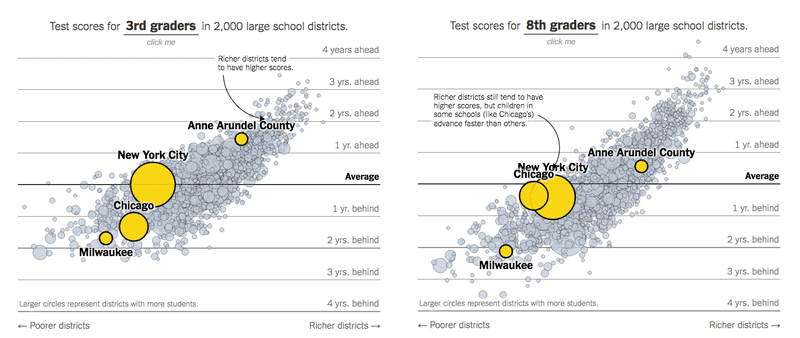
Dr. Sean Reardon, a professor at Stanford's Graduate School of Education, published a study last week with a provocative finding: median income does not always determine academic growth. The study looked at test scores of third to eighth graders in 11,000 U.S. school districts from 2009-2015.
In a New York Times report on the findings, the Chicago public school system was shown to do a better job of raising the reading and math scores from third to eighth grade than other, wealthier, school districts such as Maryland’s Anne Arundel County.
WNYC asked Dr. Reardon to analyze New York City schools. He found that third graders in New York City are, on average, scoring at grade level. However, by eighth grade, the typical student is 0.4 years behind.
Unlike in Chicago, the performance gap between New York City’s black and Hispanic students and their white and Asian peers widens between third and eighth grade. In third grade, there’s about a two-grade-level achievement gap between the groups, which is close to the national average.
“By eighth grade, the achievement gap between white and Asian students and black and Hispanic students is a little more than two and half grade levels. So it grows by 25 percent,” Reardon said.
A spokesman for the New York City Department of Education said the public school system emphasizes other measures of student achievement, including graduation rates and results from grades other than three or eight. He also cited universal pre-kindergarten and pilot programs for three year olds that aim to close the gap.
Even though Reardon's analysis found that income in a district didn't always track with academic growth, some districts in our region do demonstrate this correlation.
In the Yonkers City School District, which has a median family income of $48,000, the typical student’s test scores grow by 3.5 grade levels in five years. In Scarsdale, also in Westchester County, the median family income is $226,000, and the typical student’s test scores grew by six grade levels in five years.
To look up how your public school district compares in academic growth from third to eighth grades, check out the interactive tools by The Upshot.

